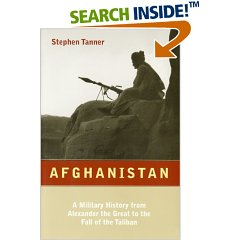
A Military History from Alexander the Great to the Fall of the Taliban on amazon.com
Salaams! How's your reading coming along? Any good books you've been challenged or stimulated by lately? Here's my latest contribution (with my NEW 10-Star Rating System™):
Afghanistan: A Military History from Alexander the Great to the Fall of the Taliban, Tanner, Stephen, Oxford University Press, 2002
Rating = ********* (9/10)
I picked this book up recently in Peshawar, Pakistan (at a GREAT for-Pak-only price!). A very well-written and paced book that covers a lot of historical ground in a short 328 pages. The recounting of Alexander's amazing conquests was fascinating reading: the destruction of the much larger Persian army in modern-day Iraq, the chasing of Darius III, the disappointment and destruction of grand Darius' capital--Persepolis, the sweep across modern-day Afghanistan and north of the Hindu Kush Mountains to establish footholds for his far-flung Macedonian empire in modern-day Bukhara and Samarkand (founding a new city he named "Alexandria-the-Furthest"--modern-day Khojent!), the battles with the fierce nomadic Scythians who lived north of the Sri Darya, and his invasion of "India" (modern-day Pakistan)--which Greek cartographers considered to be just before the end of the world.
Other highlights include the horrific conquests of the Mongol hordes led by
There is a good bit about the various kingdoms and rulers who fought and re-fought for control over parts of Afghanistan (and Pakistan, where Peshawar was a winter capital), including the two disastrous
Following ten years of fierce fighting between the Soviet/Afghan communist forces and the Afghan mujahideen fighters (helped by Pakistan, the U.S., and over 35,000 Arab & other Islamic fighters), the Soviet 40th Army pulled out its forces in February 1989; it had officially lost over 14,000 soldiers (considered a low number by most). After a few years the various Afghan mujahideen groups defeated the Afghan communist forces and took over the government power in Kabul in 1992. In-fighting and power struggles among the various mujahideen groups led to some of the worst fighting in years, this time focused on the densely populated urban centers and not the rural countryside. The destruction of much of Kabul took place during these years. In 1994, a group of Afghan Pushtun madrasseh students (based mainly in Pakistan) who became collectively known as "the Taliban" wrested control of Kandahar away from the corrupt mujahideen and began battling the other mujahideen warlords for control of the country. They were able to take control of Kabul in 1996...and eventually controlled 90% of the country under a tyrannical, fundamental grip. They were finally expulsed by the 10%-held
And the rest is on-going history!...
Some final comments from the author's "Afterword" that I think are poignant:
"It would be unwise for America to abandon Afghanistan after the recent conflict as precipitously as it did in 1989 after the Soviet withdrawal...In Afghanistan we have seen how a simple, medieval-minded mullah could be co-opted by international terrorists with cataclysmic effect. After a half-century of Cold War, the United States suffered the greatest foreign attack in its history not from the gigantic armaments of Russia or China, but at the hands of a small group based on Afghan soil" (p. 322).
-----------------------------------------------------------------------
All for now--wes
******************************************
"If you're not standing on the edge,
you're taking up too much room."
******************************************
No comments:
Post a Comment